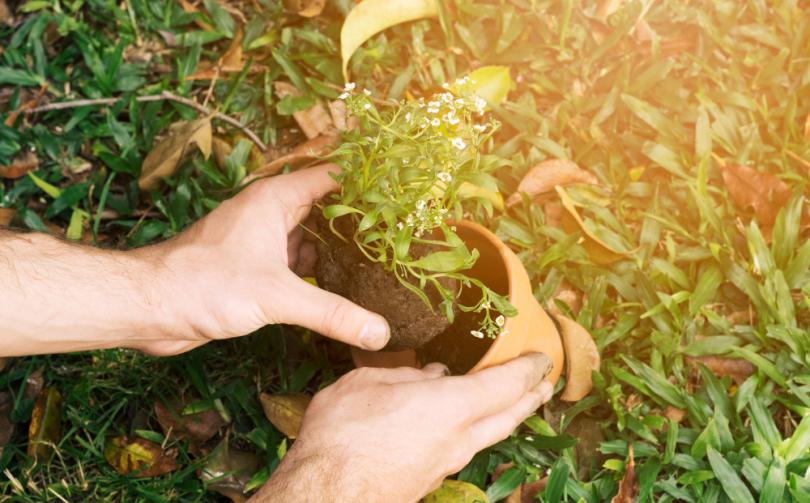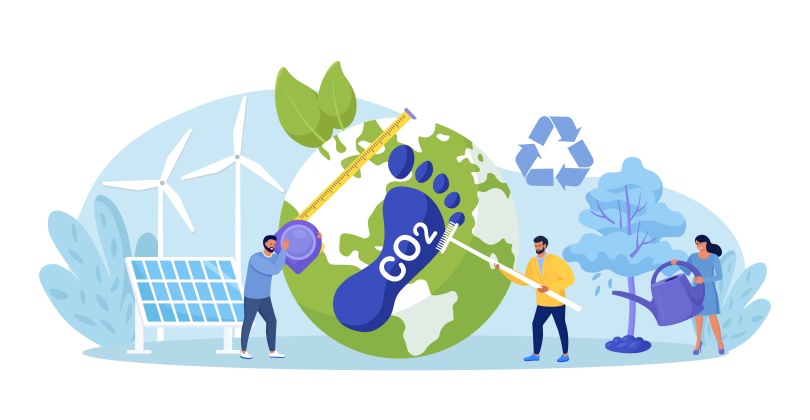As the days get longer and brighter, our minds naturally turn to thoughts of spring. However, this season is about more than beautiful blooms and warmer weather: it’s also a great opportunity for us to take stock of our ecological footprint and see where we can make small but impactful changes in our lifestyles to reduce our environmental impact.
From utilizing renewable energy sources to taking smarter commuting options, there are plenty of easy ways that each one of us can work towards reducing our ecological footprints during springtime – discovering these strategies is the focus of today’s blog post. So read on for some practical tips that will let you enjoy everything that this wonderful new season has to offer while making a positive difference in your own unique way!
1. Plant Trees and Flowers to Help Improve Air Quality

During springtime, one of the best ways to help improve air quality is by planting trees. They produce oxygen, which helps to purify our air. Additionally, trees are great for reducing smog levels in areas with large amounts of greenhouse gas emissions. Planting flowers can also help add beauty to our environment and attract beneficial insects like bees and butterflies.
Furthermore, trees and flowers can reduce our carbon emissions by absorbing excess carbon dioxide from the atmosphere and reducing greenhouse gases emission. By planting them in your backyard or local community, you can help improve air quality during springtime and create a healthier environment for everyone. Not only will you be helping the environment, but you’ll also be creating a beautiful space to enjoy during this season.
2. Recycle Paper, Plastic, Metal, and Glass Products

One of the best ways to make a positive environmental impact is by recycling. By reusing and recycling materials, we can help reduce our overall waste production while conserving valuable resources. During this springtime, it’s important that we remember to recycle paper, plastic bags, plastic bottles, and glass products whenever possible.
When shopping for new products, look for those made of recyclable materials so you can easily recycle them when they’re no longer useful. It is recommended to avoid bags which are made of single-use plastics and replace them with reusable shopping bag.
Additionally, make sure to separate these materials into different bins or bags for easy recycling. Be sure to check with your local waste management office for instructions on how to properly dispose of each type of material.
Recycling is only part of the solution; reducing food waste and reduce packaging waste can also have a major positive impact on our planet. Additionally, carrying a reusable water bottle and coffee mugs with you when out and about can help reduce plastic waste.
Let’s make a conscious effort to reduce our carbon footprint and conserve resources by recycling during this spring season. We all have the power to make a difference and create a greener, healthier planet for future generations.
3.Use Less Water When Cleaning or Gardening - A Little Goes a Long Way!

One of the most important things we can do to make our planet greener is to reduce our water usage. When it comes to cleaning and gardening, there are several simple ways that we can help conserve water and the environment. When doing household chores, use a broom or rake for outdoor areas instead of using a hose or pressure washer. This will help save both water and energy.
For frequent showers, limit the amount of time you spend in the shower and use low-flow showerheads to reduce the amount of water used per minute. For gardening, you can opt for native plants that require less frequent watering or install a drip irrigation system that helps distribute water evenly.
These simple tips can make a huge impact on the environment – one drop at a time! Try to reduce your water usage during this springtime and help our planet become greener and more sustainable.
4. Choose Your Right Food Choices to Save Our Environmental Issues

Eating right can help reduce the environmental damage caused by unsustainable food production and consumption practices. This spring, choose how much food you eat, shop local and reduce your meat consumption.
Eating in moderation is essential for a healthy lifestyle and can help minimize the environmental impact of food production. Eating too many leads to wasted resources, since all the energy used to produce excess food is wasted as well. This season, practice mindful eating habits with nutritionally balanced food items and shop local to reduce food miles.
Reducing your meat consumption or having less meat is another way to help the environment. The meat industry is a major contributor to climate change, as well as water and air pollution. This spring, choose more plant-based proteins instead of animal products and opt for sustainable sources of meat when possible.
By swapping animal-based proteins with a vegetarian diet, huge ecological footprints can be reduced. This is also beneficial to human health as vegetarianism has been associated with lower body mass index, lower cholesterol levels and lower blood pressure among other health benefits. Therefore, it is important to consider the nutritional value of food when making choices for your diet.
In addition, using organic, local or sustainable sources of food may help reduce global warming and air pollution caused by transportation or production. By cooking with organic, local ingredients, you will not only be reducing your ecological footprint but also supporting your local farmer’s market or community.
Even growing your own vegetables is another way to reduce your environmental footprint. Growing your own food reduces the distance food has to travel, and it also helps create a healthier lifestyle since you know exactly what goes into your food. By investing in local farmer’s markets, you can support sustainable agriculture practices as well as ensure animal welfare conditions are met.
5. Drive Less by Walking or Biking When Possible

Walking or biking instead of driving is a great way to reduce your ecological footprint and enjoy the beauty of springtime. Not only does it help conserve energy, but also helps you stay healthy. Walking and biking can provide a much-needed break from technology, work deadlines, and everyday stress.
By leaving the car behind, you’ll reduce your carbon footprint and reduce the amount of fossil fuels used. Consider carpooling, taking public transportation when available or even working from home if that is an option for your job.
If you do need to drive, consider electric vehicles or economy-class cars that use less gasoline. Doing this will help reduce emissions and help the environment. You can also make sure your vehicle is properly maintained which will improve fuel efficiency and reduce emissions as well. Taking a few simple steps like these can help reduce your ecological footprint while still allowing you to get to where you need to go.
So don’t forget to leave the car behind and get out and enjoy this beautiful spring! Walking and biking are great ways to reduce your ecological footprint while also enjoying some of nature’s beauty.
6.Turn Off Electronics When Not in Use
To further reduce your ecological footprint, you should make sure to turn off electronics when not in use. Leaving lights and other electronic devices on can have a major impact on the environment by increasing the amount of energy being used. By turning off these electronics when not in use, you can help conserve resources and reduce carbon emissions. Additionally, unplugging items such as laptop chargers and phone chargers when not in use can help reduce energy consumption.
You can also purchase carbon offsets to counterbalance the carbon emissions created by using electricity. Carbon offsets from Carbon/Neutral are investments into projects that aim to reduce carbon emissions, such as renewable energy or reforestation projects. Buying carbon offset is one way to reduce your personal impact on the environment.
Finally, consider replacing traditional incandescent light bulbs with LED or compact fluorescent light bulbs (CFL bulbs). LED and CFL bulbs use less energy than incandescent light bulbs, providing the same amount of light for less electricity. Additionally, LEDs and CFLs are often made from recycled materials, making them a more sustainable option.
Better yet, let the sunshine in! Enjoy the warm days this springtime and let natural light into your room!
7. Support Local Businesses That are Environmentally Friendly
By shopping locally, you are directly helping to preserve the environment. Not only do local businesses often have a smaller carbon footprint than buying from international corporations, but they also tend to be more conscious of their environmental impact and take steps to reduce it.
When you shop at local businesses that prioritize sustainability, you are actively reducing your own ecological footprint and saving money. In addition to saving money, you also know that you’re only buying what you need and not over-consuming resources. By avoiding excess consumption, you are helping to protect the environment and live a more sustainable lifestyle.
8. Wash Clothes in Cold Water Whenever Possible
When it comes to reducing our ecological footprint, washing clothes in cold water is one of the simplest and most effective things we can do. Cold water washes are more energy efficient since they don’t require heating up the water like hot or warm washes do. And best of all, cold water washes can be just as effective as hot water washes, so there’s no need to worry about compromising on cleanliness.
When it comes to saving energy and reducing our environmental impact, cold water washes are a great place to start. Cold water washes use less energy than hot or warm washes, so switching from hot or warm to cold for most of your loads can help significantly reduce your carbon footprint. Plus, cold water washes use less soap and detergent than hot or warm washes, so switching to cold can also help save you money on laundry supplies.
Another benefit of using cold water for washing clothes is that it helps preserve the color and fabric quality of clothing for longer. Hot water tends to degrade clothing fibers over time, leading to fading and damage. Cold water washes are gentler on clothes and help preserve their original color and fabric quality for many more washes.
Ultimately washing clothes in cold water is a great way to reduce energy use, save money, and protect the environment. So next time you do your laundry, make sure to switch to a cold water wash and do your part in helping reduce your ecological footprint.
Final Thoughts About Ways to Reduce Ecological Footprint During Springtime
Springtime is a great opportunity to start fresh and commit to living more eco-friendly. Every person can make a difference by taking small steps to reduce their ecological footprint. Use these ideas as inspiration for ways that you can help the environment this spring and all year long!
The warming spring temperatures encourage us all to take personal actions that reduce our ecological footprint. From seasonal gardening to home energy efficiency, there are plenty of ways for us to take control and reduce environmental impacts.
Carbon/Neutral provides an actionable strategy that you can easily commit to. Simply sign up with us and we’ll take care of all the computations needed to see how much you can reduce your ecological footprint. With Carbon/Neutral, you can trust that your contributions are helping to build a sustainable future.
Sign up today and start making a difference!
